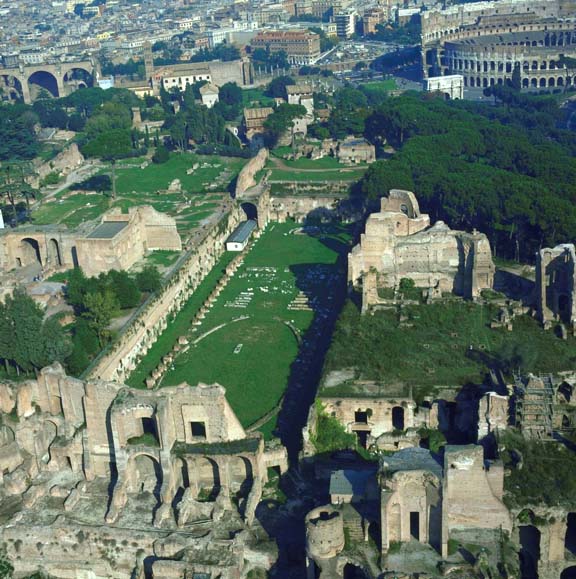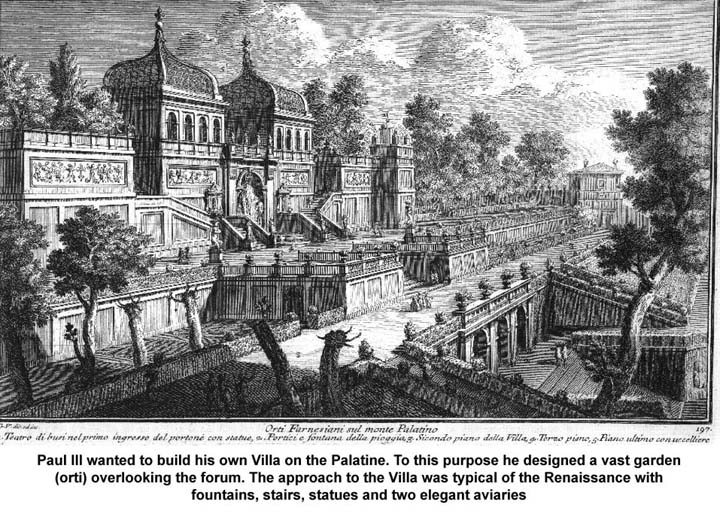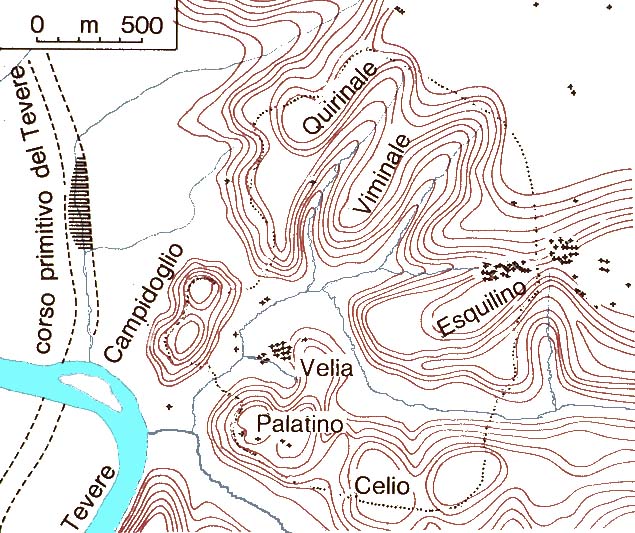

Overhead view of part of the Palatine
When the crowds in the Roman Forum get too big and boisterous, do what the Caesars did: go up to the Palatine Hill. There you will find green grass, cultivated gardens, and incomparable views down into and across the forum to the northeast, and over the Circus Maximus to the Aventine Hill to the southwest.
The palaces of the Caesars, parts of which are still in remarkably good condition, are huge, and, even after almost 2000 years, they give you some idea of how nice it must have been to be in the household of a living god. During the Republican centuries, before the Caesar's built their palaces, the Palatine Hill was an elite residential area, and before that it was where Romulus built his hut and established his outlaw community. Traces of even earlier settlement have been found. But it is the imperial phase that grabs the eye. Even without their sheaths of white marble, colored mosaics, the paintings, and golden roofs, the real Caesar's Palaces put tacky Las Vegas to shame. Also on the hill are the still fabulous Renaissance gardens constructed between 1540 and 1550 for Cardinal Alessandro Farnese.

As is the case everywhere in Rome, some parts of the Palatine are inaccessible due to construction and renovation, and some digs are still under way. The parts that are open, however, are more than you can really see in one or even several days. There are two entrances, one through the Republican Forum, just west of the Arch of Titus, and the other on Via di San Gregorio, halfway between the Colloseum and the south-eastern end of the Circus Maximus. The recommended route is through the Forum.
Enter the Forum from the Largo Romulo e Remo on Via dei Fori Imperiali. (Pause here to use the restrooms -- the next one is far away -- and to buy a Forum/Palatine map or the Palatine guide book. Don't buy the Palatine Museum book: it's full of inaccuracies, and everything in the Museum is labeled). Turn left at the bottom of the ramp and head for the Arch of Titus. From there you can see the ticket kiosk at the base of the Palatine. As you enter the Palatine, don't follow the ramp up the hill that is directly in front of you. Instead, climb the stairway to your right, stopping on the first platform to see the view over the forum. Climb more steps, stopping to see the fishpond and the moss covered waterfall and pausing at various stages to see the views. At the top there is an overlook of the forum from the balcony between the twin pavilions of the Vignola aviary that is heart-stopping, (and that's why this is the recommended route.)
Use your map or guide book to navigate around the various sites on the hill, or just wander around. In either case, find your way to the opposite side, behind the Museum, and stand at the top of the big curved wall to look out over the Circus Maximus. That's exactly the spot where the Caesar's stood to watch the triumphal entrances of victorious Generals as they progressed through the Circus Maximus and around the southern end of the Palatine, before entering the Forum on the Sacred Way (the Via Sacra). Somewhere below, on the slope, is where Romulus killed Remus, starting Rome's bloody fratricidal tradition. On a clear day you can see Alba Longa (CastelGandolfo), where Romulus and Remus were born, over your left shoulder.
When you have absorbed all that history, find the hippodrome. It's size and location will surprise you every time you see it. Walk around it and remember that it probably was never intended for horseracing. At most it was made for a leisurely canter among trees and shrubs and decorative pillars, a picnic area for the Caesars and their guests.
Exit reluctantly by wending your way down ramps and stairways to the Via di San Gregorio. The exit (also an entrance) is through a transplanted Renaissance gateway. There are (at last) more restrooms inside the gate and another store in the gatehouse. When you go out the gate, look left to see the Arch of Constantine and the Coliseum or right to see the remains of the aqueduct that brought water to fill the Caesars' bathtubs and across the street, Pope Gregory the Great's church.
Palatine hill maps: http://www.geocities.com/Athens/Forum/1274/palatine-hill.html
------------------
Palatine Chronology:
10th century BC: VillaNovan stone age relics
753 BC: Roma Quadrata of Romulus
Republic: First densely populated, then "urban renewed" into villas for the rich, including Cicero, Pompey, J.Caesar
By 1 AD: House of Augustus -- Augustus, by now also Pontifex Maximus, gives the old Regia in the Forum to the Vestals and moves up the hill, buying and consolidating several properties.
1st - 3rd centuries AD: first Julio-Claudians, the Flavians expand the House of Augustus and build additional palaces
Medieval: Frangipani family turns the complex into a fortress
16th century: Renaissance villas, especially Farnese family -- Pope Paul 3 -- Counts Palatine
I7th century: Vigna Barberini -- Barberini Vineyards
1861: Purchase by Napoleon 3 -- Modern excavations start
20th/21st centuries: Now an Italian
Government/Comune Rome property -- excavations continue

Below -- Roman Topography
